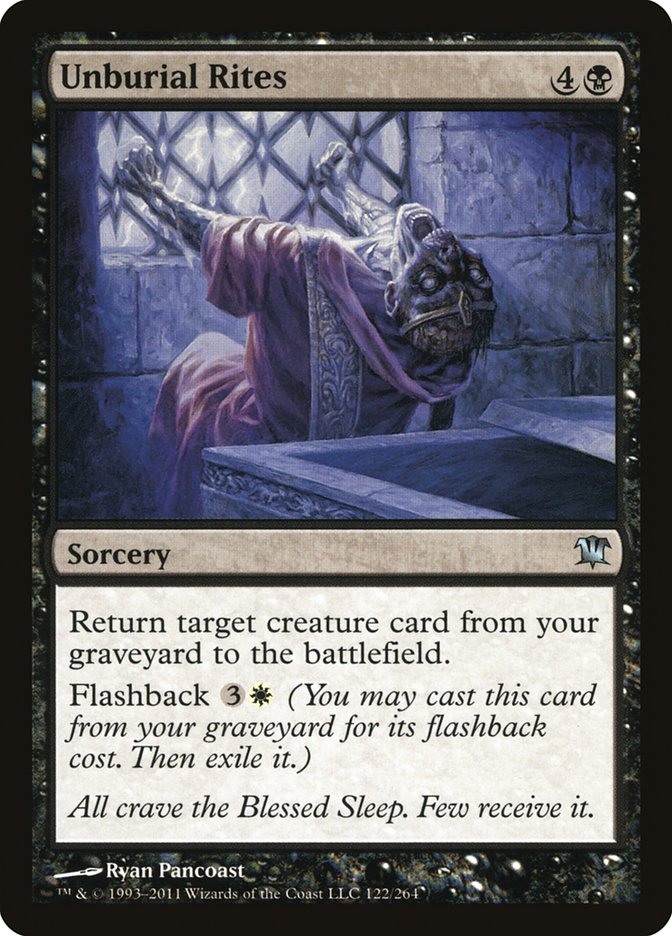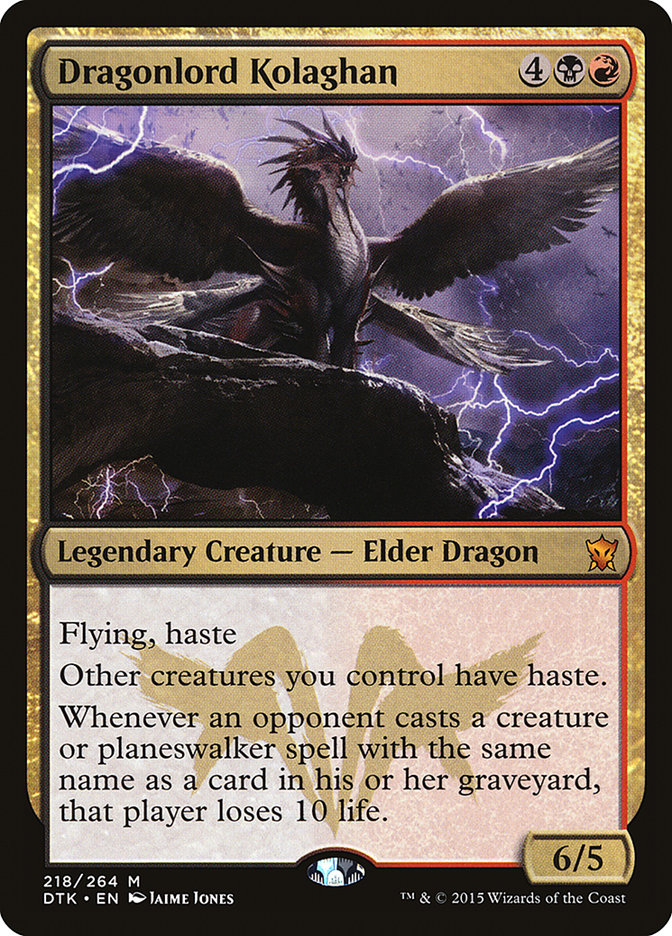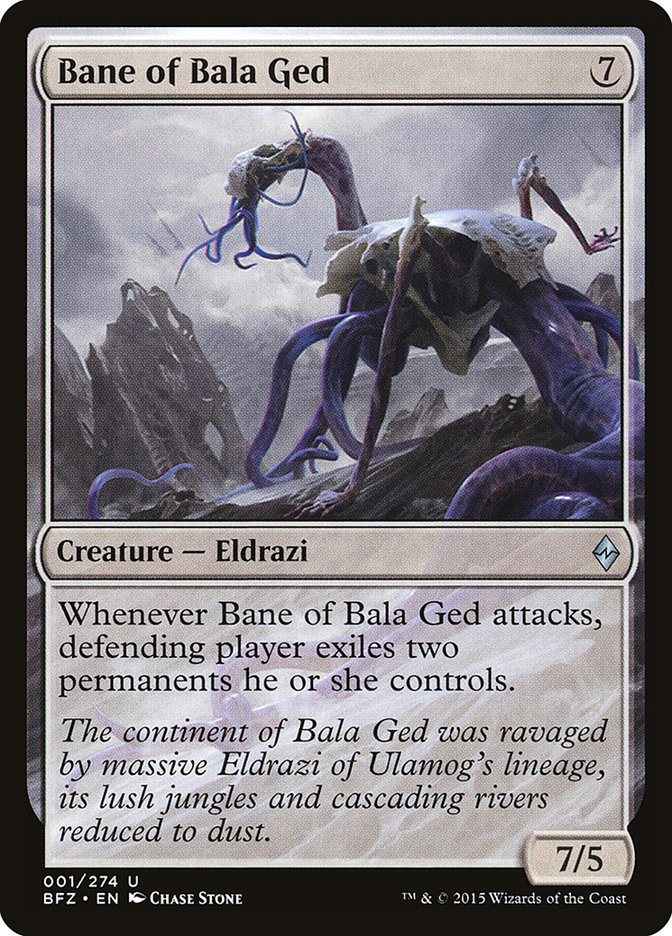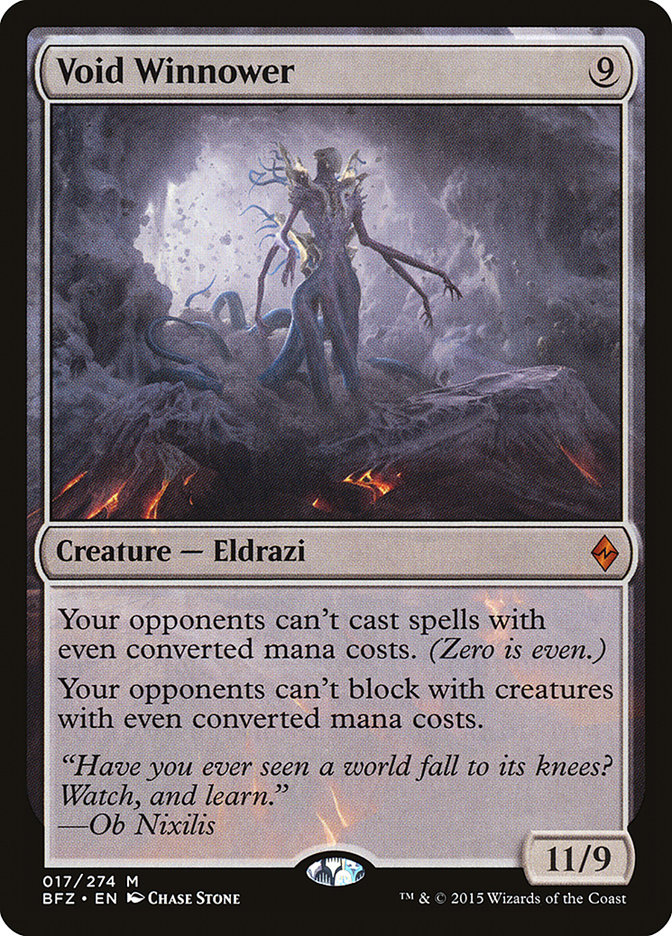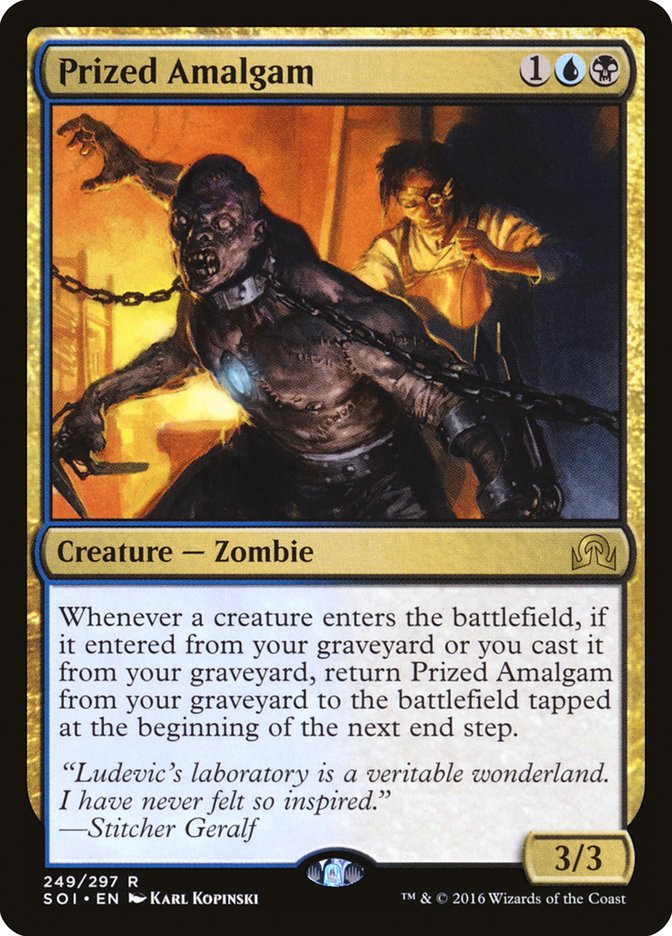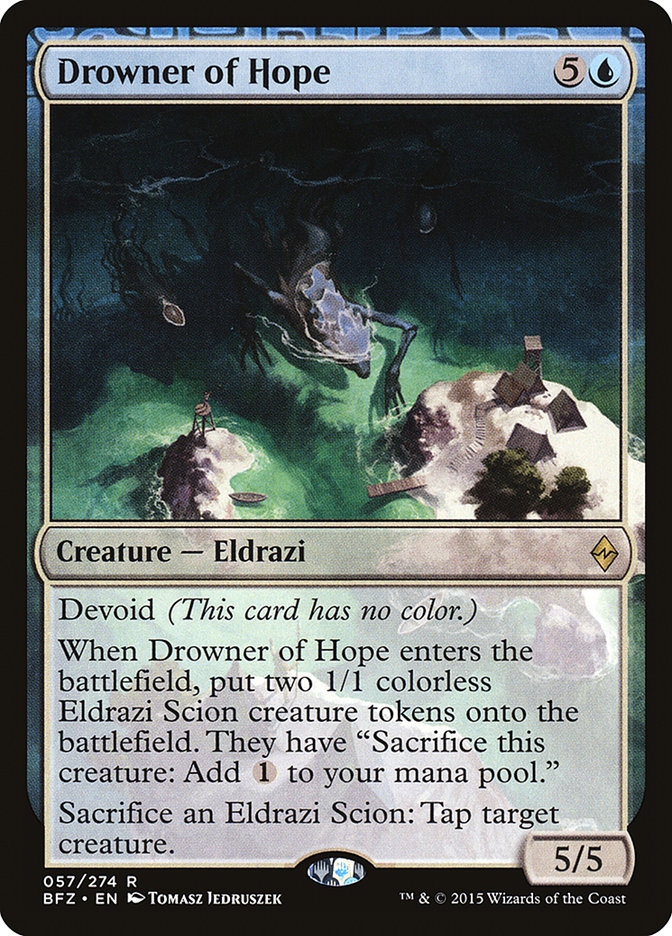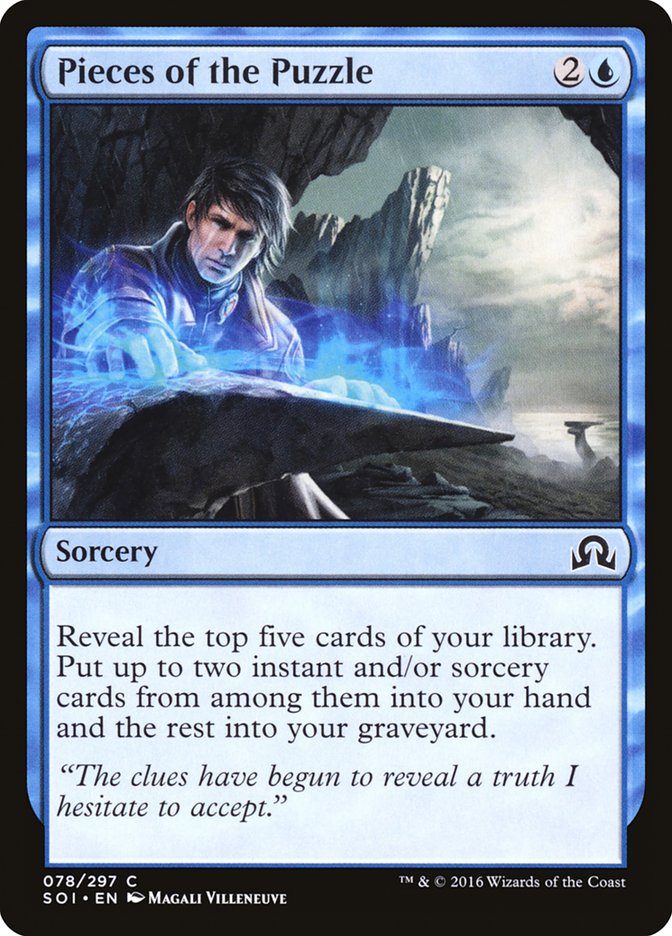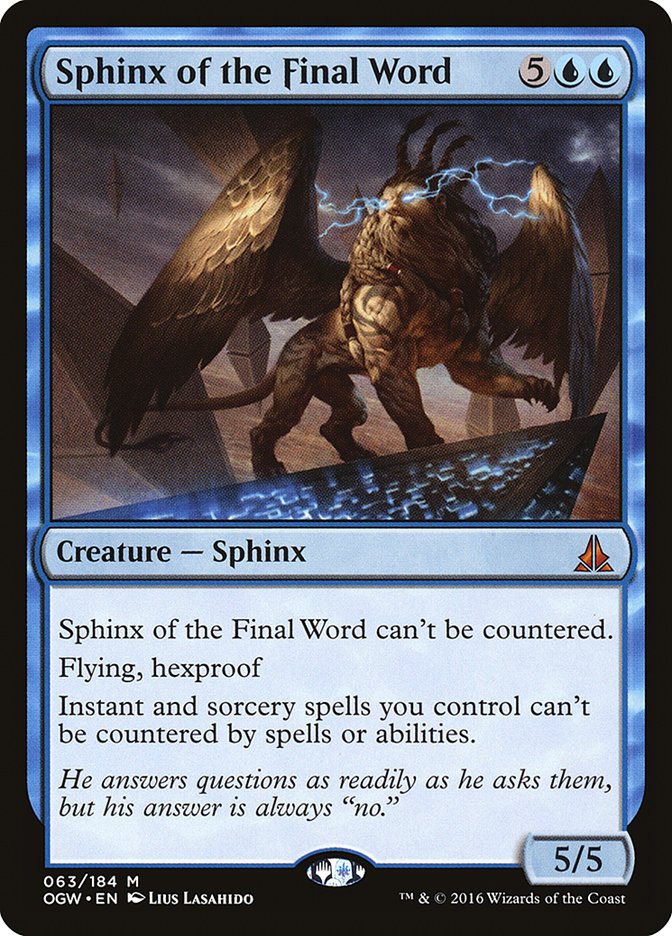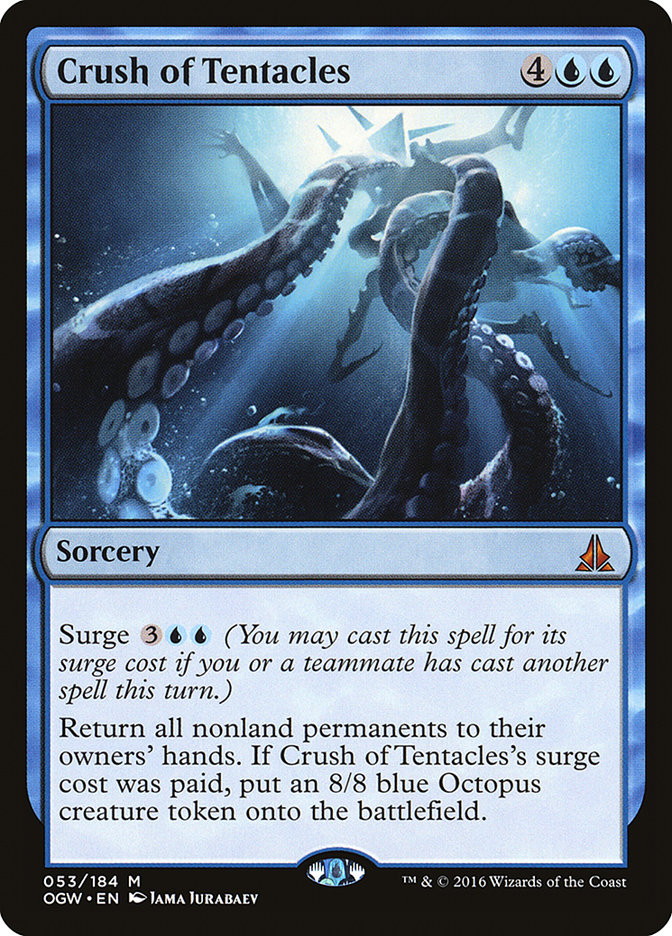 Unburial Rites.
Unburial Rites.
This sorcery was one of the most beautiful and powerful spells in all of Innistrad. All of the un-fairest princes and princesses of Magic longed to capture its power. It had many suitors, from the greatest Beasts to the purest Angels, and each clamored to be targeted. Opponents couldn’t overpower the powerful combination of reanimation, enters-the-battlefield effects, lifegain, and token generation. Before long, this most beautiful of spells became oppressive and tyrannical, and Innistrad was swallowed by the shadow of its dark magic. Only Sir Calendar could save the Magic world.
Soon, Sir Calendar heard our plea, arriving to vanquish the terrible beast Unburial Rites had become. With it, however, Innistrad was destroyed, left to ruin. Unburial Rites was etched into the annals of the plane, a grim reminder of the mighty power of unchecked necromancy.
In neighboring planes, the Reign tried year after year to regain its former glory. Whip of Erebos and Obzedat, Ghost Council made a combined effort to retake the throne, but their tenure was short-lived. Recently, another upstart threatened to ripple the still waters of casted creatures, as Rally the Ancestors reanimated small targets, sacrificing them to Nantuko Husk. The weight of subjugation rested on the shoulders of the princes and princesses of Magic once more, but soon it, too, rotated.
This is where our story continues. Now that we’re back on Innistrad, reanimation appears to be thwarted once and for all. Creatures do not possess as many powerful triggers on entering the battlefield anymore. Even the mighty Eldrazi possess cast triggers, preventing reanimation abuse. Spells cannot easily be cast in alternative ways, and the only reanimation fuel left burns with a cool flame. No tournament-worthy deck has contained reanimation spells since Sir Calendar vanquished Rally the Ancestors.
We were safe again. Maybe at last, finally, we could live happily.
Ever After is one of Shadows over Innistrad’s most flavorful and most inherently powerful cards. The ability to choose any two creatures in your graveyard and reanimate them is undeniably thrilling, encouraging you to fill your deck with powerful creatures to bring back. Although the creatures of today’s Standard format cannot be as easily abused as previous offenders like Restoration Angel and Thragtusk, there is an undeniable power in simply getting a pair of creatures back for six mana.
Reanimation decks built today will look considerably different from reanimation decks in the past, which were solely focused on dumping powerful creatures into your graveyard, finding the one reanimation spell you needed, and casting it to create such an oppressive battlefield state that your opponent would not be able to rob you of your advantage, attack, or block effectively. Many creatures have prohibitive mana costs for a reason; they’re not supposed to enter play on turn 3, 4, or 5.
As always, reanimation decks have three major components: the reanimation targets, means by which to get reanimation targets into your graveyard, and ways to reanimate those targets. Nearly everything within that deck should be or support one of these three components.
Reanimation decks have always been about speed; getting an eight-drop out on turn 4 is much better than on 6, so that’s why it’s important to cut cards that do not service this plan and operate with the correct combination of components to do this reliably, efficiently, and quickly. A reanimation deck might contain good targets and good reanimation spells, but without the proper efficient support, you’re likely to be stuck with the wrong combination of cards in your hand at any one time.
Ever After is a little different. Ever After possesses the power of single-target reanimation, but you get to do it twice for what’s turned out to be about one mana more than the going rate for similar effects. Because Ever After gets two cards, it makes sense from a flavor and gameplay perspective to make sure the two targets you have work well together.
Dragonlord Kolaghan has two qualities that make it an exceptional reanimation target: it can attack immediately upon returning to the battlefield and it has evasion. Pairing the Dragonlord with any other creature also provides them haste, which can turn games around single-handedly. Well, double-handedly, I guess.
Powerful enters-the-battlefield triggers are less common, and if Dragonlord Kolaghan is an attractive target because of the haste it provides, it may follow that powerful attackers might replace those triggers. Or, in some cases, you can have both.
This Languish-proof Eldrazi has seen play on and off in the sideboards of various green-based ramp decks, but combined with the haste of the Dragonlord, Bane of Bala Ged is an easily accessible Eldrazi that is not out of the realm of possibility to cast.
While it does not possess a trigger, Void Winnower does have a strong static ability, preventing some of the format’s most powerful spells from being cast and many of its creatures from blocking. Reanimating this early enough can put your opponent off Collected Company, Cryptolith Rite, Pia and Kiran Nalaar, and powerful planeswalkers like Nahiri, the Harbinger; Chandra, Flamecaller; and Sorin, Grim Nemesis. Tokens can’t block, either.
This should be enough to get started!
Creatures (14)
- 2 Dragonlord Kolaghan
- 2 Ulamog, the Ceaseless Hunger
- 2 Void Winnower
- 2 Bane of Bala Ged
- 2 Ghoulsteed
- 4 Insolent Neonate
Planeswalkers (2)
Lands (24)
Spells (20)
Sideboard

Creatures
Insolent Neonate is a special creature. For one mana, it can toss a bulky reanimation target from your hand and replace it. It can help you hit your land drops efficiently with the extra draw; perhaps most importantly, it can block. The Neonate is a critical piece of this puzzle, and while its activation is usually card disadvantage, this deck is sacrificing card advantage already, and it’s an investment we’re looking to recoup. The fact that you can save the draw for later and then activate it without spending mana is an added bonus.
Ghoulsteed is a great proxy to put other cards in the graveyard later, and when you activate it, you even get a 4/4 out of the deal. Not bad! Ulamog, the Ceaseless Hunger is the more powerful out of the two Eldrazi Titans from Battle for Zendikar, even without taking cast triggers into account. In the same time period, Kozilek, the Great Distortion could attack twice and be blocked by two sets of two tokens, but Ulamog will have destroyed their library. Easy choice.
Spells
Here’s our support. Lightning Axe provides quick discard access for very little mana, and smashing the majority of unaided creatures for one mana will always be a winner. This deck is not designed to flatten swaths of creatures before sideboarding, so Lightning Axe will have to target the most threatening creature, and you’ll have to deal with the rest. Tormenting Voice is a great draw spell when you also want to discard, and it’s a mainstay of the deck. Read the Bones also helps this while providing actual card advantage. You’ll be discarding plenty of cards in the deck, so you’ll want relevant replacements when you can get them.
Vessel of Volatility is a critical addition to the deck, putting both Ever After and the actual reanimation targets within a more reasonable range. An on-time Vessel of Volatility allows for a turn 4 Ever After, and based on the gameplan of this deck, it’s likely you’ll have two legitimate targets in your graveyard when you get there. Chandra, Flamecaller is an amazing planeswalker, providing limitless utility through a hand exchange, battlefield sweep, or finisher. You really can’t go wrong with this fiery lady, and Vessel of Volatility can also propel you to her on turn 4.
Lands
The most interesting land in the deck is Drownyard Temple; it’s easy to discard it, and turn 3 will often be an idle turn for this deck, making a discarded Drownyard Temple legitimate ramp. The rest of the lands make up for the color lost to the Temple, and the flexibility of red and black mana is more important than having lots of untapped sources. To live the turn-4 Ever After dream, you need two black mana and at least one red mana to activate a Vessel, so the color matters.
Sideboard
Thanks to Bane of Bala Ged, casting Kozilek’s Return and “flashing it back” is a real possibility. It’s a great token sweeper, and it helps in the early turns against white-based Humans decks. Its graveyard mode sweeps away most everything, and even if it hits your own stuff, who cares? You’ll get it back! Virulent Plague does much the same thing, and Duress and Ruinous Path are present mostly to off those annoying planeswalkers.
Orbs of Warding, which can come down as early as turn 3, protects us from Duress effects as well. The deck does not gain much life, so Orbs of Warding provides significant padding by providing hexproof and reducing incidental damage. Volcanic Vision is a bit narrow, but I like the idea of recovering a discarded Ever After. Casting Ever After tucks it on the bottom of your library, but getting a discarded one back while smashing your opponents’ creatures for six sounds exhilarating.
I’ve been testing this deck for the last couple of weeks, and overall, it’s good. Most of the revisions that led me to the final list above are to improve consistency and message. The deck has just one plan, and while it’s fun to get there, it sometimes doesn’t, and you’re often left with a bit of a mess in your hand or, in many cases, no hand at all.
The discard plan to get cards in the graveyard was quite taxing, and there were several instances where, without doing much, I just ran out of resources. Four Ever After, as opposed to some combination of Ever After and Necromantic Summons, was the right call, though; I never wanted the latter. Ever After turned games around; I just had to get to that point.
The deck was a bit swingy and it often lost to itself. It won, too, but it had difficulty getting out of a bad situation. I wanted something more consistent.
Prized Amalgam has all the makings of a powerful reanimation card: solid body, free reanimation, and a relevant creature type and cost. Moving into blue opens up other paths to putting cards in the graveyard. The newly printed Stitchwing Skaab and Geralf’s Masterpiece are considerably more efficient than Ghoulsteed from the first deck while providing the same level of control, and these cards are legitimate threats.
We can’t forget about Ever After, though; what can our target be if we’re moving away from high-cost Eldrazi?
Oh, maybe just another high-cost Eldrazi, but with a bit of blue.
No matter how it enters the battlefield, Drowner of Hope grants two more tokens, and two entering together give four tokens, which in turn provide mana for more spells or creatures! You could chain them together and use the Eldrazi Scions generated for blocking, attacking, tapping, or mana. That’s a lot of flexibility attached to an easily castable 5/5!
There are lots of good spells for a plan like this in blue, and there’s even some room for actual removal. Let’s try this out instead!
Creatures (14)
Lands (26)
Spells (20)

This deck is a little more straightforward, but I want to highlight one card that makes a gargantuan difference between the two decks: Pieces of the Puzzle.
This card does everything this deck wants. It puts cards in my hand to cast or feed a Zombie while putting the rest of the cards in my graveyard, perhaps even one of those Zombies. You literally can’t lose. Most of the time, I don’t want to draw a creature, so milling them away is not a problem. In a perfect world, you’re hitting two critical spells and placing Stitchwing Skaab and two Prized Amalgams in the graveyard, giving you a latent nine power at your command.
Epiphany of the Drownyard and Nagging Thoughts provide a similar function, but Nagging Thoughts is far more consistent; after Game 1, your opponent will be onto your plan and Epiphany gets much worse. Still, late in the game, it can get pretty big, especially if you use Eldrazi Scions to power out a big one!
The land isn’t too special this time around; Drownyard Temple is a bit more of a crutch this time, but it’s still an untapped land in the worst circumstances.
The sideboard contains a playset of a weird card: Invasive Surgery. That’s right, there’s four of them. This deck is very susceptible to some of the format’s most frequently played sorceries. Declaration of Stone is a card I never want to see. Transgress the Mind can hit any threat in my hand. Infinite Obliteration or Pick the Brain can destroy me. Languish can prevent me from closing the deal. Seasons Past can provide them unlimited advantage.
There are a million reasons to play Invasive Surgery, and while the deck does only sport four card types, it can get them into the graveyard with enough regularity that delirium is quite possible. Languish is a concession to decks that go wide, which is a surprising number of them these days. Crush of Tentacles and To the Slaughter provide ways to deal with planeswalkers, and casting the former with Surge gives me a really juicy target. Replay that Drowner of Hope, tap their freshly recast blockers, and get ’em dead! Sphinx of the Final Word is a powerful reanimation target, and it forces through my own Negates, Ever Afters, and removal spells.
I’ve been testing this list since April, and it has not disappointed. It struggles against Cryptolith Rite decks and Collected Company is not easy, but it has won good games of Magic against every major archetype, before and after sideboarding. It does particularly well at midrange and control matchups, where its hard-to-kill threats and card selection put the right cards in my hand and graveyard with striking regularity.
Another thing about this deck? It’s cheap, especially if you already have Languishes. No single card in this deck is over $4, the dual lands being the most expensive non-sideboard cards. I built this bow to stern on Magic Online for only sixteen tickets, replacing Languish with some Infinite Obliterations and Just the Winds that I already had.
Both online and in paper, I’ve loved playing this deck. It’s still a fairly linear gameplan, but I’ve been able to get aggressive draws with multiples of Prized Amalgam where I just beat down, rebuy them with a discarded Stitchwing Skaab, and watch as my opponent ran out of answers. Ever After on Drowner of Hope was outstanding, turning a losing situation into a winning one so quickly I got whiplash. If you miss the glory days of reanimation and want a taste, this deck is the one for you.
Ever After is abstractly more powerful that many reanimation spells from the past, but its presence in a metagame filled with creatures that interact mostly through combat and incidental synergies makes it an exciting yet unique strategic choice this time around. Although reanimation is back, the format that surrounds affords those players who enjoy that strategy and those who oppose it to both live happily ever after.
What pairing have you found for your Ever After?

